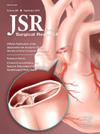癌症委员会关于肺癌标准5.8的观点:一项定性研究
IF 1.7
3区 医学
Q2 SURGERY
引用次数: 0
摘要
2021年,癌症委员会实施了标准5.8,该标准要求在所有治疗意图肺癌切除术中,从≥1个肺门和≥3个不同的纵隔淋巴结站取样淋巴结。虽然预计所有癌症委员会认可的医院80%符合标准,但最近的数据表明,目前只有一半的医院符合标准。我们评估了在实施标准5.8中感知到的障碍和促进因素。方法在本多中心定性研究中,在学术和社区机构进行了20次半结构化访谈。我们采访了主要利益相关者,包括胸外科医生、病理学家、手术室工作人员、癌症联络医师和临床数据分析师。有针对性地实施慢性病核对表,促进了专题分析。结果主题被映射到六个针对慢性疾病领域的定制实施。大多数参与者认为该指南没有负担,也没有改变他们的临床实践。尽管许多人同意应该存在淋巴结评估的最低阈值,但一些参与者不确定支持证据,并确定了实施的潜在技术和临床障碍。跨学科合作是遵守法规以及与专业协会指导方针保持一致的关键促进者。除了部门领导和支持外,更高的合规率被认为是由增加的监控和绩效反馈所驱动的。结论:关于标准5.8的不同意见与目前较低的国家合规率一致。与会者强调需要更多的证据来支持该标准,强调了未来前瞻性研究的重要性。支持强有力的跨学科交流,定期安排反馈,心脏科学会和部门领导的认可可以提高依从性。本文章由计算机程序翻译,如有差异,请以英文原文为准。
Perspectives on Commission on Cancer Standard 5.8 on Lung Cancer: A Qualitative Study
Introduction
In 2021, the Commission on Cancer implemented Standard 5.8, which requires that lymph nodes be sampled from ≥1 hilar and ≥3 different mediastinal lymph node stations for all curative-intent lung cancer resections. While 80% compliance is expected of all Commission on Cancer–accredited hospitals, recent data illustrates only half of sites are currently meeting criteria. We evaluated perceived barriers and facilitators in implementing Standard 5.8.
Methods
In this multicenter qualitative study, 20 semistructured interviews were conducted across academic and community-based institutions. We interviewed key stakeholders, including thoracic surgeons, pathologists, operating room staff, a cancer liaison physician, and clinical data analysts. Thematic analysis was facilitated by the tailored implementation for chronic disease checklist.
Results
Themes were mapped to six tailored implementation for chronic disease domains. Most participants felt the guideline was not burdensome and did not alter their clinical practices. Although many agreed that a minimum threshold for lymph node evaluation should exist, some participants were uncertain of the supporting evidence and identified potential technical and clinical barriers to implementation. Interdisciplinary collaboration was a key facilitator to compliance, as well as alignment with professional society guidelines. Higher compliance rates were thought to be driven by increased monitoring and performance feedback, in addition to departmental leadership and support.
Conclusions
Mixed opinions regarding Standard 5.8 align with currently low national compliance rates. Participants emphasized the need for additional evidence to support the standard, underscoring the importance of future prospective studies. Support for strong interdisciplinary communication, regularly scheduled feedback, endorsement by cardiothoracic societies and departmental leadership may improve compliance.
求助全文
通过发布文献求助,成功后即可免费获取论文全文。
去求助
来源期刊
CiteScore
3.90
自引率
4.50%
发文量
627
审稿时长
138 days
期刊介绍:
The Journal of Surgical Research: Clinical and Laboratory Investigation publishes original articles concerned with clinical and laboratory investigations relevant to surgical practice and teaching. The journal emphasizes reports of clinical investigations or fundamental research bearing directly on surgical management that will be of general interest to a broad range of surgeons and surgical researchers. The articles presented need not have been the products of surgeons or of surgical laboratories.
The Journal of Surgical Research also features review articles and special articles relating to educational, research, or social issues of interest to the academic surgical community.

 求助内容:
求助内容: 应助结果提醒方式:
应助结果提醒方式:


